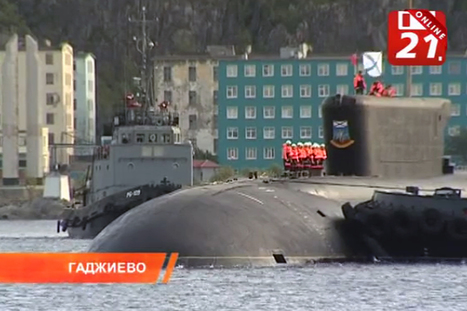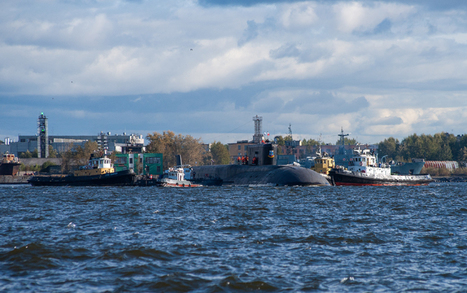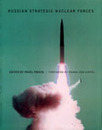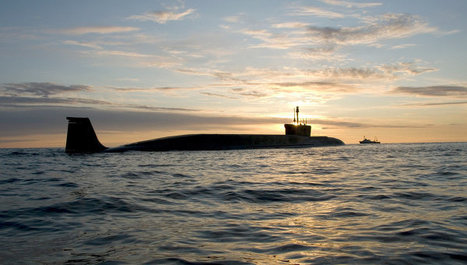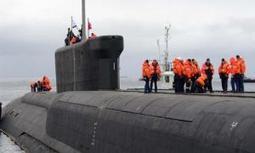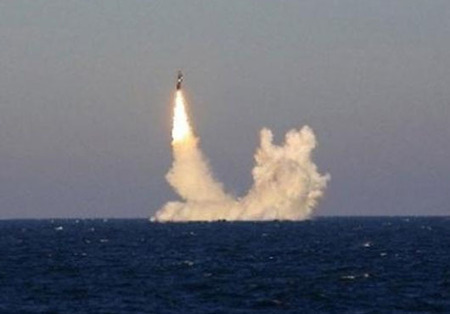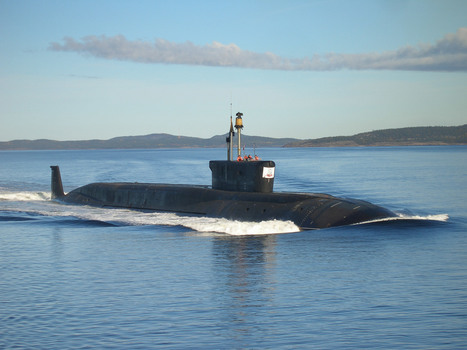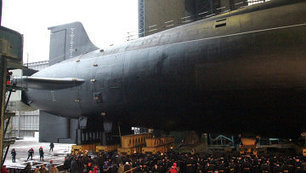 Your new post is loading...

|
Scooped by
Patrick H.
September 10, 2013 10:37 AM
|
Strategic submarine with missiles that might not work arrives to port on Kola ten months after President Vladimir Putin supervised the official handover. Friday was supposed to be a game-changer date in Russia’s strategic missile forces. A test launch of the new said-to-become super ballistic missile Bulava should prove its readiness simultaneously as the first submarine to carry the missiles would arrive at her homeport Gadzhiyevo. The test launch, supposed to be the final, took place from the “Aleksandr Nevsky” in the White Sea. It failed as reported by BarentsObserver yesterday. While a commission will look into what went wrong this time, further tests of the missiles are halted. While the missile launch failed in the White Sea, the Northern fleet’s orchestra was lined up at a pier in the naval town of Gadzhiyevo north of Murmansk on the coast to the Barents Sea. A tug vessel assisted “Yury Dolgoruky” to the pier. A video-news from the event is posted by the regional broadcaster TV21 in Murmansk. The event happened ten months after the submarine was handed over to the navy from the Sevmash shipyard. President Vladimir Putin witnessed the flag hoisting ceremony from a video-link in Severomorsk, while Defense Minister Sergei Shoigu was in the central command post of the sub at port in Severodvinsk. In Moscow, Vice Premier and former Ambassador to NATO, Dmitry Rogozin posted a message on Twitter commenting that “Yury Dolgoruky” was ready for mission. “Дрожите, буржуи! Кирдык вам).” English translation would be something like: "Shiver, bourgeois! You’re done with!)." The word “буржуи» is Soviet slang for capitalists or foreigners. Russian media reports this week says nothing about why it took ten months from the submarine was handed over to the navy until she arrived to Gadzhiyevo. “Yury Dolgoruky” is like the other Borey class submarines especially designed to carry the Bulava missile and cannot carry other intercontinental missiles, like the Sineva that are onboard the fleet of Delta-IV class submarines. While “Yury Dolgoruky” stays at port in Gadzhiyevo with weapons that could be called the Emperor’s new clothes, the Defense Ministry has put trails of the two next submarines in the class on hold, reports RIA Novosti. A total of eight Borey-class submarines are planned to join the navy by 2020. Awaiting the results from the state commission investigation of last week’s test failure, the current missiles onboard “Yury Dolgoruky” might have to be pulled out of the tubes and checked. The submarine can carry 16 missiles.

|
Scooped by
Patrick H.
September 9, 2013 7:46 AM
|
Le lancement du missile intercontinental Boulava, issu de la première série mise en service, a échoué vendredi dernier. Le ministre russe de la Défense Sergueï Choïgou a donc décidé de suspendre les essais de deux porteurs du missile: les sous-marins nucléaires lanceurs d'engins (SNLE) Alexandre Nevski et Vladimir Monomakh, écrit lundi 9 septembre le quotidien Kommersant. Leur mise en service sera très probablement reportée à 2014. Une commission spéciale est aujourd’hui chargée d'enquêter sur les causes de l'incident mais comme l'objectif du lancement était de tester le système balistique du sous-marin - et non pas de vérifier les performances de Boulava - le missile n'était pas doté d'équipements télémétriques, ce qui complique la tâche des inspecteurs. La suspension des essais des SNLE du projet 955 Alexandre Nevski et Vladimir Monomakh a été annoncée samedi dernier par le service de presse du ministère de la Défense. La porte-parole du ministère a également ajouté que Sergueï Choïgou avait décidé d'organiser cinq lancements supplémentaires du missile Boulava afin de vérifier ses performances techniques. Personne n'a prononcé, depuis, de commentaires officiels sur l'échec du lancement de Boulava – élément central des forces russes de dissuasion nucléaire. Le missile a été lancé le 6 septembre à 7h20 heure de Paris, depuis le SNLE Alexandre Nevski immergé en mer Blanche sur le polygone de Koura, au Kamtchatka. Après l'ordre envoyé par le poste de commandement central du QG, le missile a quitté son silo mais à la deuxième minute de vol un dysfonctionnement s'est produit dans le système de contrôle du deuxième étage de Boulava. Selon une source, l'incident a été rapporté à Sergueï Choïgou une demi-heure après les faits et 10 minutes plus tard, il en rendait compte au président Vladimir Poutine qui se trouvait à cet instant au sommet du G20 à Saint-Pétersbourg. Une source de l'administration présidentielle a souligné que le lancement du missile n'était pas associé à la présence de Poutine au sommet. "Si le lancement avait réussi, le président aurait pu l'annoncer personnellement en présence d'autres chefs d'Etat". Le porte-parole du président Dmitri Peskov a toutefois démenti cette éventualité. "Le chef de l'Etat n'aurait jamais annoncé le premier essai réussi d'une arme quelconque, qui plus est pendant le sommet du G20, a-t-il déclaré. En cas de réussite, Sergueï Choïgou aurait pris rendez-vous avec le président pour lui en rendre compte personnellement." On pourrait supposer qu'en cas de réussite les agences de presse en auraient immédiatement parlé. Une commission spéciale a été créée sous la direction de l'amiral Viktor Tchirkov, chef de la marine, pour déterminer les causes de l'incident. Selon certaines informations, le vice-premier ministre Dmitri Rogozine, qui supervise le complexe militaro-industriel, a rencontré samedi dernier les représentants du ministère de la Défense et, notamment, de l'Institut des technologies thermiques de Moscou. "L'Institut des technologies thermiques de Moscou n'est absolument pas responsable : il est donc inutile de parler des mesures à entreprendre en termes de personnel, a déclaré hier l'un des membres de la commission d'enquête. La responsabilité revient certainement à une entreprise du consortium." La commission militaro-industrielle a officiellement confirmé la réunion mais s'est refusée à tout commentaire.

|
Scooped by
Patrick H.
September 4, 2013 6:15 AM
|
On September 3, 2013, Yuri Dologorukiy, the lead submarine of the Project 955 Borey project, left the Sevmash plant for the naval base in Gadzhieyvo, where it will join the Northern Fleet. The submarine was officially accepted for service in December 2012. At that time it was reported that it will not get its missiles until January 2014. In a related development, the NOTAM data suggest that Russia will conduct a Bulava launch between September 6 and 10, 2013. It was reported earlier that two test launches are scheduled for 2013 - a single-missile launch from Aleksandr Nevskiy and a salvo launch from Vladimir Monomakh. Aleksandr Nevskiy is expected to be accepted for service on 15 November 2013.

|
Scooped by
Patrick H.
June 18, 2013 5:44 AM
|
La Marine russe envisage d'effectuer deux tirs d'essai du missile balistique Boulava au cours de l'année 2013, a annoncé à RIA Novosti une source haut placée au sein de l'Etat-major général. Prévus au troisième et quatrième trimestre de l'année en cours, les tirs seront effectués depuis deux sous-marins nucléaires du projet 955 Boreï – Alexandre Nevski, Vladimir Monomakh. En cas de succès, les deux sous-marins nucléaires lanceurs d'engins (SNLE) seront adoptés par les forces navales russes avant la fin de l'année. Capables de tirer des missiles balistiques Boulava, les sous-marins de classe Boreï constitueront la base des Forces maritimes stratégiques russes après la mise au rebut des sous-marins de classes Akoula (Typhoon selon le code de l'OTAN), Kalmar et Mourena (Delta-3 et Delta-4 selon l'OTAN) en 2018. Le premier sous-marin de la série, Iouri Dolgorouki, a été remis à la Marine russe en janvier dernier.

|
Scooped by
Patrick H.
April 12, 2013 2:25 AM
|
YEKATERINBURG, April 11. (ARMS-TASS). Until the end of 2013 it is planned to perform 2.1 ballistic missile submarines (SLBM) "Bulava". This was announced today at a press conference in the regional information center "TASS-Ural" Director General of FSUE "NPO Automation" Leonid Shalimov. According to him, these launches will be "proof of the consignment." Shalimov said that the complex "Bulava" is put into pilot operation of a full-time, so all the contingencies that may occur during start-up, "Mace", related to workmanship, not of design. According to ITAR-TASS in early February, a source in Russia's "defense" at the end of June - beginning of July, the first production nuclear submarine of project 955 (code "Northwind") "Alexander Nevsky" will be released in the sea to continue the state tests. "The crown of state tests in July, will be shooting a" Bulava ", which first must be performed by a team sent from Moscow to the new automated command and control system of the missile launches," - he said. "If such a command of the General Staff will be on the boat launcher, by launching an automatic countdown and the subsequent launch of a missile, it would be reasonable grounds for making rocket complex" Bulava "on arms," - he added. Solid RSM-30 "Bulava" have a range of more than 10 thousand km and equipped with multiple warheads individual targeting (HSR AI). Submarine 4th generation Project 955 "Borey" can carry 16 of these missiles. NPO Automation - one of the leading Russian companies in the design and manufacture of control systems and electronic equipment for the rocket and space technology.

|
Scooped by
Patrick H.
February 23, 2013 3:30 PM
|
MOSCOW, February 20 (RIA Novosti) – Russia's upgraded Project 955A (Borey-A) class nuclear-powered strategic submarines will carry only 16 Bulava ballistic missiles each rather than the 20 missiles previously reported, a senior defense industry source said on Wednesday. “The Project 955A differs significantly from the original Borey (Project 955) but not in the number of missiles carried – there will still be 16 on board,” the source said. At the same time, the improved vessels are equipped with advanced sonar, navigation, communications and fire-control systems and have lower electromagnetic signature, which makes them more “stealthy,” the official added. Previous media reports, including those from RIA Novosti, had reported the Project 955A as being armed with 20 Bulava missiles. The first submarine of the improved Borey-A class, the Knyaz Vladimir, was laid down in July 2012. The construction of the Alexander Suvorov, the fifth in the series and second of the improved Project 955A (Borey-A) class, will begin on July 28, when Russia celebrates Navy Day, while the sixth submarine, the Mikhail Kutuzov, will be laid down in November. The Borey class submarines are set to become the mainstay of the Russian Navy's strategic nuclear deterrent fleet, replacing the ageing Project 941 (NATO Typhoon class) and Project 667 class (Delta-3 and Delta-4) boats. Russia’s first Borey class submarine, the Yury Dolgoruky, officially entered service with the Russian Navy on January 10. It has been assigned to the 31st submarine division of the Northern Fleet. Russia is planning to have three Borey class and five Borey-A class submarines by 2020.

|
Scooped by
Patrick H.
January 18, 2013 11:07 AM
|
Russia today started mooring tests of the third Borey-class ballistic submarine “Vladimir Monomakh”. ladimir Monomakh will be the third and last Project 955 boat that is armed with 16 Bulava ballistic missiles. The fourth and subsequent boats will be Project 955A vessels with 20 missiles. As BarentsObserver reported, the first submarine of the class, “Yury Dolgoruky”, was taken into service on January 10 after twelve years of construction. The second vessel of the class, “Aleksandr Nevsky” is currently undertaking sea trials and is due to enter service later this year. The fourth sub, “Knyaz Vladimir”, is under construction. Sevmash shipyard in Severodvinsk reports that sea trials of “Vladimir Monomakh” will start this summer. As previously reported by BarentsObserver, the inclusion of the “Yuri Dolgorukii” in the Northern Fleet marks a shift in Russia’s nuclear forces. The number of nuclear warheads based on submarines will no longer go down, it starts to rise again.

|
Scooped by
Patrick H.
January 11, 2013 12:09 PM
|
During the flag raising ceremony at the Yuri Dologorukiy submarine, the first in the Project 955 class, Commander of the Russian Navy reported that the Navy "paid special attention to the torpedo armament [of the new submarine] and its capability to carry long-range cruise missiles." That is, of course, in addition to the 16 Bulava ballistic missiles that will be deployed on Project 955 submarines. The cruise missile in question is most likely the 3M10/RK-55 Granat or maybe a newer missile, Kalibr (which was recently tested in a launch from the Severodvinsk Project 885 attack submarine). The missiles can be launched from one of the eight standard 533-mm torpedo tubes deployed on Project 955 boats. A submarine of this class is reported to carry up to 40 weapons that could use torpedo tubes, but these would include torpedoes and anti-ship missiles as well as long-range SLCMs. These cruise missiles, of course, can carry nuclear warheads, although at this point there is no reason to believe that they will. Setting aside the question why would a strategic missile submarine need long-range SLCMs on board, this is an interesting development that brings back the discussion of whether Russia counts long-range SLCMs as strategic delivery vehicles and therefore whether it believes they should be covered by the 1992 pledge to remove all tactical nuclear weapons from its surface ships and submarines. I looked into this issue some time ago and I believe that my main conclusion still stands - Russia did remove all nuclear SLCMs from its submarines and reported zero deployed missiles in its annual declarations. I would still argue that in doing so Russia effectively accepted that long-range SLCMs are non-strategic systems, but I admit that it is not a very strong argument. As long as the START reporting arrangement was in place, it provided an enforcement mechanism of sorts, but it expired with the START treaty in December 2009, so nothing prevents Russia from asserting its position that long-range nuclear SLCMs are not covered by the 1992 pledge. There is a proposal to resume the START SLCM data exchange, but I don't see why Russia would agree to do that. More likely, it will prefer to maintain ambiguity and to leave its options open. Any discussion of further nuclear reductions would have to deal with SLCM anyway, so it's not something that would derail the process (not that it needs help with that). But the gray status of nuclear SLCMs as systems that are not covered by New START but at the same time not really non-strategic would definitely complicate things.

|
Scooped by
Patrick H.
January 8, 2013 1:18 PM
|
The third submarine of the Project 955 Borey class, Vladimir Monomakh, left covered dock at the Sevmash plant on December 30, 2012. Construction of the ship, which began in 2006, will continue. Vladimir Monomakh is expected to begin sea trials in 2013 and might be ready to enter service in 2014. It is the last submarine of the Project 955 class with 16 Bulava launchers on board - the next boat, Prince Vladimir, is built as a Project 955A submarine. Earlier, the Navy announced that the first Project 955 submarine, Yuri Dolgorukiy, will be accepted for service on 30 December 2012. This procedure, however, was postponed and would probably take place in January 2013. No reason for the change of plans was given. UPDATE 01/03/13: According to CAST blog, Sevmash and the navy signed the acceptance act on 29 December 2012. It was only the formal flag-raising ceremony that was postponed. UPDATE 01/08/13: The flag raising ceremony will take place on January 10, 2013.

|
Scooped by
Patrick H.
January 3, 2013 2:02 AM
|
МОСКВА, 30 дек — РИА Новости. Торжественная церемония поднятия флага на атомном подводном крейсере "Юрий Долгорукий", головного корабля проекта 955 "Борей", не состоялась, сообщили РИА Новости в воскресенье в пресс-службе ОАО "Севмашпредприятие". "Торжественная церемония поднятия флага на АПЛ "Юрий Долгорукий" не состоялась", — сообщили в пресс-службе, не уточнив причину. В свою очередь источник в ОПК сообщил РИА Новости, что флаг будет поднят в январе. Он добавил, что приемо-сдаточный акт АПЛ "Юрий Долгорукий" подписан.

|
Scooped by
Patrick H.
December 26, 2012 12:20 PM
|
Le missile balistique intercontinental Boulava et son lanceur, le sous-marin nucléaire lanceur d'engins Iouri Dolgorouki(classe Boreï) seront adoptés par l'armée russe avant la fin de l'année en cours, a déclaré mercredi aux journalistes le vice-ministre de la Défense Iouri Borissov. "L'adoption du sous-marin stratégique Iouri Dolgorouki est prévue avant fin décembre 2012. Nous avons toutes les raisons d'assurer que ce plan sera mené à bien. Le missile Boulava sera adopté en tant que composant du sous-marin, mais sera en phase d'essai au cours de l'année 2013", a indiqué la source. Capables de tirer les missiles balistiques Boulava, les sous-marins de classe Boreï constitueront la base des Forces maritimes stratégiques russes après la mise au rebut des sous-marins de classes Akoula (Typhoon selon le code de l'OTAN), Kalmar et Mourena (Delta-3 et Delta-4 selon l'OTAN) en 2018. Le chantier naval russe Sevmach de Severodvinsk (nord) héberge actuellement trois sous-marins de cette classe à différents stades de construction (Iouri Dolgorouki, Alexandre Nevski et Vladimir Monomakh). Le quatrième sous-marin, nommé officieusement Sviatitel Nikolaï (Saint Nicolas), sera le premier navire de nouvelle classe Boreï A, dont les caractéristiques seront supérieures à celles de la classe Boreï. Au total, Sevmach envisage de construire huit sous-marins de classes Boreï et Boreï A.

|
Scooped by
Patrick H.
December 20, 2012 3:26 PM
|
18.12.2012 Головную атомную подводную лодку четвертого поколения "Юрий Долгорукий" могут принять в состав ВМФ России до конца текущего года, сообщил 17 декабря гендиректор оборонной судоверфи Севмаш Михаил Будниченко.
По его словам, "конец года может стать для атомохода "Юрий Долгорукий" знаковым - ожидается подписание приемного акта", передает ИТАР-ТАСС.
Будниченко отметил, что первый серийный крейсер этого проекта "Александр Невский" в ближайшее время выйдет в море на государственные испытания.
Кроме того, завершается строительство еще одного серийного "Борея" - "Владимир Мономах" и продолжается строительство подводной лодки "Князь Владимир", заложенной летом этого года по усовершенствованному проекту 955А.
30 октября головная стратегическая атомная подводная лодка "Юрий Долгорукий" проекта 955 (шифр "Борей") завершила государственные испытания и предъявлена флоту для принятия на вооружение.

|
Scooped by
Patrick H.
December 20, 2012 1:22 PM
|
Russian defense ministry confuted press reports that SLBM Bulava would be allegedly launched by nuclear submarine Alexander Nevsky early July 2013.
|

|
Scooped by
Patrick H.
September 10, 2013 3:00 AM
|
Another stage of testing a nuclear powered submarine of the new generation The Aleksandr Nevsky is over, press service of the Sevmash defense shipyard, which built the nuclear-powered ship, said on Monday. During a week in the White Sea the submarine’s all systems and weapons were being tested. “The objectives the ship had were completed successfully,” Sevmash’s Acting CEO Sergei Marichev said. “We have completed tests of the military hardware. Everything was done normally. The crew fulfilled all the time norms for giving and implementation of fighting management.” “On Friday, the strategic nuclear powered submarine Aleksandr Nevsky fired a Bulava inter-continental missile from the White Sea at the Kura test range in the Kamchatka Peninsula. The missile left the launch container normally, but its onboard system failed during the second minute in flight,” a Defense Ministry spokesman told the media on Saturday. According to the official Shoigu made a decision to suspend the certification tests of The Aleksandr Nevsky and The Vladimir Monomakh submarines and to make five extra launches of the Bulava missile in order to verify its technical parameters. “A commission under the Russian Navy’s Commander-in-Chief, Admiral Vladimir Chirkov, is looking into the causes of the Bulava missile’s failed launch,” the Defense Ministry’s spokesman has said. First published by Itar-Tass.

|
Scooped by
Patrick H.
September 7, 2013 2:09 AM
|
La Russie a suspendu les tests d'homologation de deux sous-marins nucléaires, Alexandre Nevski et Vladimir Monomakh, suite à l'échec d'un tir d'essai du missile Boulava, a annoncé samedi le ministère russe de la Défense. "Le sous-marin nucléaire russe Alexandre Nevski, qui passe des tests d'homologation en mer Blanche, a tiré vendredi un missile balistique intercontinental Boulava qui devait détruire une cible sur le polygone de Koura, au Kamtchatka. Le missile a quitté son conteneur sans problème, mais son système de bord est tombé en panne à la 2e minute du vol. Le ministre russe de la Défense Sergueï Choïgou a décidé de suspendre les tests d'homologation des sous-marins Alexandre Nevski et Vladimir Monomakh pour effectuer cinq tirs supplémentaires du missile Boulava et tester les paramètres techniques et tactiques du missile", a indiqué un porte-parole du ministère devant les journalistes. "Une commission dirigée par le commandant en chef de la Marine Victor Tchirkov a lancé une enquête sur l'échec du tir de Boulava", a-t-il ajouté. Selon les informations précédentes, Alexandre Nevski devait être livré à l'armée à la mi-novembre et Vladimir Monomakh en décembre 2013, à l'issue de tests d'homologation. Capables de tirer des missiles balistiques intercontinentaux Boulava, les sous-marins nucléaires lanceurs d'engins (SNLE) Alexandre Nevski et Vladimir Monomakh (projet 955 Boreï) constitueront la base des Forces navales stratégiques russes après la mise au rebut des sous-marins de classes Akoula (Typhoon selon le code de l'OTAN), Kalmar et Mourena (Delta-3 et Delta-4 selon l'OTAN) en 2018. Le premier sous-marin de la série, Iouri Dolgorouki, a été remis à la Marine russe en janvier dernier. Le missile R30 3M30 Boulava-30 (code OTAN SS-NX-30, dénomination internationale RSM-56) doit devenir l'arme principale des forces stratégiques navales russes. Le Boulava est un missile à trois étages à propergol solide destiné à équiper les sous-marins. D'une portée de 8.000 km, il peut être équipé de dix ogives nucléaires hypersoniques de 100 à 150 kt et à trajectoire indépendante.

|
Scooped by
Patrick H.
July 5, 2013 8:06 AM
|
Le premier tir d'essai du missile balistique Boulava de l'année 2013 sera effectué en septembre depuis le sous-marin nucléaire lanceur d'engins Alexandre Nevski, a annoncé vendredi à RIA Novosti le directeur général du chantier naval russe de Sevmach, Mikhaïl Boudnitchenko.
"Conformément au calendrier des tests, un missile Boulava sera tiré depuis le sous-marin Alexandre Nevski en septembre prochain. Pour l'instant, nous ne projetons qu'un seul tir", a indiqué l'interlocuteur de l'agence.
L'Etat-major général de la Marine russe avait annoncé plus tôt que deux tirs de missiles Boulava étaient programmés pour l'année 2013 et devaient être effectués depuis deux sous-marins nucléaires du projet 955 Boreï – Alexandre Nevski et Vladimir Monomakh.
En cas de succès, les deux sous-marins nucléaires lanceurs d'engins seront adoptés par les forces navales russes avant la fin de l'année en cours.

|
Scooped by
Patrick H.
June 10, 2013 1:17 PM
|
Le SNLE Vladimir Monomakh (Projet 955) se prépare pour ses premiers essais en mer. (i-mash) Le sous-marin classique B-800 Kaluga (Projet 877) va quitter les installations de Zvezdotchka (Severodvinsk) le 13 juin prochain pour subir des essais en mer après modernisation. Il est prévu que le submersible réintègre le service actif avant la fin de l'année 2013. La modernisation du B-800, admis chez Zvezdoctchka en 2002, a permis de prolonger de 10 ans sa durée de vie. (Itar-tass)

|
Scooped by
Patrick H.
April 2, 2013 3:38 AM
|
MOSCOW, April 1 (RIA Novosti) - A third Project 955 Borey-class nuclear-powered strategic submarine will start trials in the White Sea in June, United Shipbuilding Corporation President Andrei Dyachkov said on Monday. The Vladimir Monomakh was floated out last December and is due to enter service in 2014. The first Project 955 Borey-class submarine, the Yury Dolgoruky, was commissioned into the Northern Fleet in January, and the second, the Alexander Nevsky, will be handed over to the Russian Navy by the end of the year, a Navy official told RIA Novosti last Friday. The Alexander Nevsky has been undergoing trials at the Sevmash shipyard since 2012. There will be three sea trials this year and a Bulava ballistic missile will be test-launched from the submarine in the summer, the official said. The first three vessels in the Borey series are capable of carrying 16 Bulava submarine-launched ballistic missiles. A total of eight Borey-class submarines are to be built for the Russian Navy by 2020. Sevmash will start construction this year of two upgraded Borey class Project 955A submarines - the Alexander Suvorov and the Mikhail Kutuzov - capable of carrying 20 ballistic missiles each. Borey class submarines are to become the mainstay of the navy's strategic nuclear deterrent, replacing the ageing Project 941 (NATO Typhoon class) and Project 667 class (Delta-3 and Delta-4) boats.

|
Scooped by
Patrick H.
February 5, 2013 10:37 AM
|
Ongoing sea trials of the Russian submarine Alexander Nevsky are to include firing a Bulava ballistic missile in July, ITAR-Tass reported on Monday. "In late June and early July the Alexander Nevsky will put to sea for further state tests, which will include maneuver tests, electromagnetic field measurements, torpedo tests and others," according to a defense sector insider. "The tests will be crowned by the firing of a Bulava ICBM in July on command from Moscow to be transmitted by a new automatic combat missile launch control system." Should the firing go as planned, the vessel would return to the Sevmash shipyard for further work. It could then become the second Borei-class submarine to enter naval service. "We hope this will happen no later than the autumn." Russia intends by 2020 to build eight Borei and Borei A-class submarines for its Northern and Pacific fleets. Each craft would be equipped to carry the Bulava, which had a troubled development process marked by several trial launch failures.

|
Scooped by
Patrick H.
January 13, 2013 5:15 AM
|
Russia is to start building two new advanced nuclear-powered Borei class submarines before year’s end. Once complete, they will be lurking under the sea with 20 Bulava nuclear intercontinental ballistic missiles each. One of the submarines may be named Aleksandr Suvorov after one of the most decorated generals of the Russian Empire, a source in the defense industry told the media. Its construction is expected to start on July 28, which is Russian Navy Day. The second vessel is likely to be named after Mikhail Kutuzov, the iconic Russian general of the Napoleonic Wars. Its keel is to be laid down in November. The vessels are to be built by the shipbuilder Sevmash in Severodvinsk in the north of Russia. Both submarines are of the Borei class, the most modern strategic nuclear-powered submarines in the Russian Navy. The lead vessel of the class, Yury Dolgoruky, officially entered service on Thursday, with two of his sister-ships currently afloat and undergoing trials. The two new vessels are distinct from those three, being of an advanced Borei-A version of the same design. They will carry 20 nuclear ICBMs each, as opposed to 16 on the older submarines. They will also have improved maneuverability and better weapon control systems and will generate less noise. Russia plans to build five Borei-A submarines. The first of them, Knyaz Vladimir, is already in construction.

|
Scooped by
Patrick H.
January 10, 2013 12:16 PM
|
SEVERODVINSK, 10 janvier - RIA NovostiLe sous-marin nucléaire Iouri Dolgorouki (SNLE) a été officiellement remis à la Marine lors d'une cérémonie qui s'est déroulée aux chantiers navals Sevmach de Severodvinsk (nord de la Russie), annonce jeudi un correspondant de RIA Novosti.
La cérémonie a eu lieu en présence du ministre russe de la Défense Sergueï Choïgou.
Les sous-marins nucléaires de type Iouri Dolgorouki (classe Boreï) constitueront la base des Forces maritimes stratégiques russes après la mise au rebut des sous-marins de classes Akoula (Typhoon selon le code de l'Otan), et Kalmar et Mourena (Delta-3 et Delta-4 selon l'Otan) en 2018. La Russie compte en construire huit d'ici 2015.
Le premier sous-marin de la série, le Iouri Dolgorouki, a été mis en chantier en 1996. Long de 170 m et large de 13,5 m, il a un tirant d'eau de 24.000 t et doté de 12 missiles Boulava-30 et de lance-torpilles.

|
Scooped by
Patrick H.
January 3, 2013 2:20 AM
|
Le sous-marin lanceur nucléaire stratégique « Vladimir Monomakh », qui est le le troisième du projet 955 « Boreï », a été lancé ce dimanche à Severodvinsk. Les essais d'amarrage et en mer du navire débuteront en janvier 2013. La construction du sous-marin lanceur « Vladimir Monomakh » a débuté le 19 mars 2006. Le navire appartient à la quatrième génération de sous-marins stratégiques. Le navire est équipé de 16 (selon d'autres sources –de 20) lanceurs de missiles balistiques intercontinentaux du déploiement en mer P-30 « Boulava-30 » et de six tubes lance-torpilles de 533 mm.

|
Scooped by
Patrick H.
December 29, 2012 1:55 AM
|
SAINT-PETERSBOURG, 28 décembre - RIA Novosti Le sous-marin nucléaire russe Iouri Dolgorouki, capable de lancer des missiles balistiques Boulava, sera remis à la Marine dimanche 30 décembre, selon le service de presse du concepteur du navire. La signature de l'acte de remise du sous-marin nucléaire Iouri Dolgorouki, le premier navire du projet 955 Borei, aura lieu 30 décembre dans les chantiers navals Sevmach de Severodvinsk", indique la source dans un communiqué. Le concepteur précise, par ailleurs, que le jour même le sous-marin Vladimir Monomakh, sera mis à l'eau pour procéder à une série de tests. Capables de tirer les missiles balistiques Boulava, les sous-marins de classe Boreï constitueront la base des Forces maritimes stratégiques russes après la mise au rebut des sous-marins de classes Akoula (Typhoon selon le code de l'OTAN), Kalmar et Mourena (Delta-3 et Delta-4 selon l'OTAN) en 2018.

|
Scooped by
Patrick H.
December 20, 2012 3:38 PM
|
Russia’s third strategic submarine of the Borey-class “Vladimir Monomakh” will be put on water on December 30. The navy also announces start of design work for the 5th generation submarines and a series of underwater drones. “The Vladimir Monomakh will be floated out on December 30 and its construction will continue as planned,” Navy Commander Admiral Viktor Chirkov told RIA Novosti on Wednesday. “Vladimir Monomakh” is the third of Russia’s new giant 170 meters long nuclear powered Borey-class submarines that can carry up to 16 ballistic missiles with multiple warheads. The troubled Bulava missile, however, is not yet accepted for duty. The two first vessels of the class, the “Yury Dolgoruky” and the “Aleksandr Nevsky” are undergoing sea trails, sailing in and out from the Sevmash naval yard in Severodvinsk in the White Sea.... ...The navy commander also announced at his summary-2013 press-conference on Wednesday that by 2020, Russia will start serial construction of autonomous underwater drones and sea robots,

|
Scooped by
Patrick H.
December 20, 2012 1:24 PM
|
Новейшая стратегическая атомная подводная лодка (АПЛ) "Юрий Долгорукий" (проект 955, шифр "Борей") перед принятием на вооружение в 2013 году отработает ряд контрольных задач в море, в том числе на больших глубинах.
|



 Your new post is loading...
Your new post is loading...

